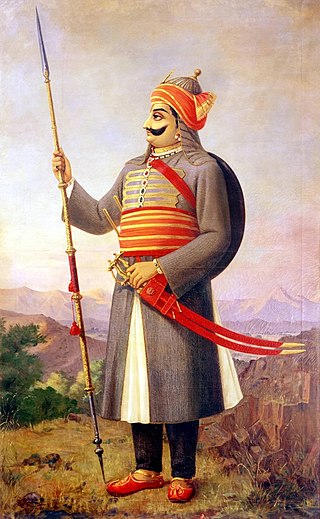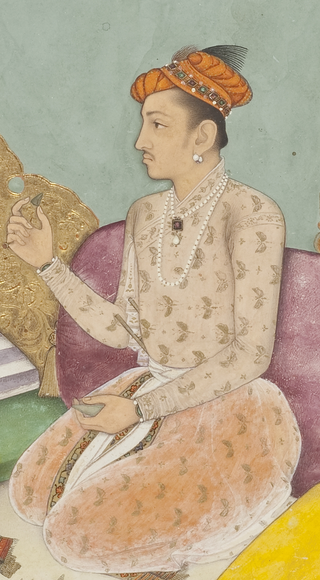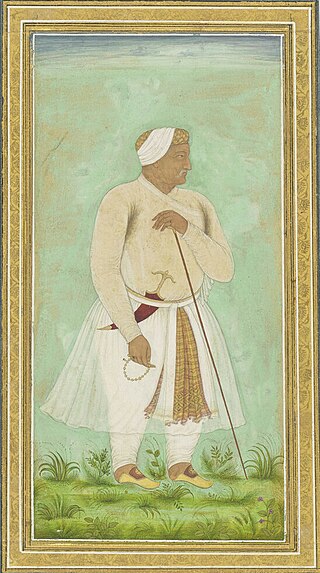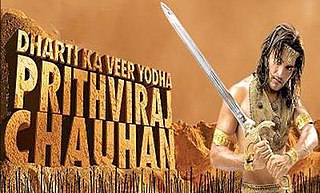
Pratap Singh I, popularly known as Maharana Pratap, was a king of Mewar, a region in north-western India in the present-day state of Rajasthan. He is notable for leading the Rajput resistance against the expansionist policy of the Mughal Emperor Akbar including the Battle of Haldighati and Battle of Dewair which have turned him into a folk hero.

Prithviraja III, popularly known as Prithviraj Chauhan or Rai Pithora, was a king from the Chauhan (Chahamana) dynasty who ruled the territory of Sapadalaksha, with his capital at Ajmer in present-day Rajasthan. Ascending the throne as a minor in 1177 CE, Prithviraj inherited a kingdom which stretched from Thanesar in the north to Jahazpur (Mewar) in the south, which he aimed to expand by military actions against neighbouring kingdoms, most notably defeating the Chandelas.

The Kachhwaha, or Kachawa is a Rajput clan found primarily in India.

Mirza RajaMan Singh I was a Kachhwaha Rajput prince who became the 24th Maharaja of Amber from 1589 to 1614 and the Subahdar of Bengal for three terms from 1595 to 1606. He served in the Imperial Mughal Army under Emperor Akbar. Man Singh fought sixty-seven important battles in Kabul, Balkh, Bukhara, Bengal and Central and Southern India. He was well versed in the battle tactics of both the Rajputs as well as the Mughals. He is commonly considered to be of the Navaratnas, or the nine (nava) gems (ratna) of the royal court of Akbar.
Jaya-chandra was a king from the Gahadavala dynasty of northern India. He is also known as Jayachchandra in inscriptions, and Jaichand in vernacular legends. He ruled the Antarvedi country in the Gangetic plains, including the important cities of Kannauj and Varanasi. His territory included much of the present-day eastern Uttar Pradesh and some parts of western Bihar. The last powerful king of his dynasty, he was defeated and killed in 1194 CE, in a battle near Yamuna against a Ghurid army led by Muhammad of Ghor.

The Prithviraj Raso is a Braj language epic poem about the life of Prithviraj Chauhan. It is attributed to Chand Bardai, who according to the text, was a court poet of the king.
Samyukta, also known as Sanyogita or Sanjukta, was the daughter of Jaichand, the King of Kannauj, and one of three wives of Prithviraj Chauhan. The love between Prithviraj and Samyukta is one of India's most popular medieval romances, composed by Chand Bardai in Prithviraj Raso.

The Kingdom of Amber, also known as Kingdom of Dhoondar and Jaipur State, was located in the Dhundhar region of Rajputana and was ruled by the Kachhwaha clan. It was established by Dulha Rai, possibly the last ruler of the Kachchhapaghata dynasty of Gwalior who migrated to Dausa and started his kingdom there with the support of Chahamanas of Shakambhari in the 11th century. Mostly through 12th to 15th century, the kingdom faced stagnation, sources are scarce. Its ruler, Chandrasen became a Sisodia vassal and fought in the Battle of Khanwa under Prithviraj Kachhwaha.

Jai Singh I was a senior general of the Mughal Empire and the Raja of the Kingdom of Amber. His predecessor was his grand uncle, Mirza Raja Bhau Singh.

Raja Bhagwant Das was the 23rd Kacchwaha ruler of Amber. His sister, Mariam-uz-Zamani, was the chief consort of Mughal emperor Akbar and mother of his successor, emperor Jahangir. His son, Man Singh I, one of the Navaratnas of Akbar became the highest-ranking official of his court and his daughter, Man Bai, was the first and chief wife of Prince Salim.

Dharti Ka Veer Yodha Prithviraj Chauhan is an Indian historical drama broadcast on Star Plus. It was produced by Sagars which is based on Prithviraj Raso, a Brajbhasha poem by Chand Bardai which portrays the life of Prithviraj Chauhan, a 12th-century Rajput emperor in India. Rajat Tokas played the younger Prithviraj Chauhan and Anas Rashid played adult Prithviraj Chauhan.
The Battle of Maonda and Mandholi was fought between the Rajput rulers of Jaipur and the Jat rulers of Bharatpur in 1767 in Rajasthan. Jawahar Singh of Bharatpur was leading an army back from Pushkar when the forces of Madho Singh of Jaipur met them by Maonda and Mandholi villages, near present-day Neem ka Thana. The battle resulted in the rout of the Bharatpur army by the Jaipur forces.
Askaran was a sixteenth-century Rajput monarch. Though briefly Raja of Amber, for the majority of his life Askaran was the ruler of Narwar. He also had a distinguished career as a military officer under the Mughal emperor Akbar and rose high in his service. He was also the maternal grandfather of Manavati Bai, consort of Emperor Jahangir and mother of Emperor Shah Jahan.
The Mughal–Rajput Wars were a series of battles fought between the Rajput Confederacy and the Mughal Empire which started with the Timurid ruler Babur's invasion of northwestern India and the head of the Rajput confederacy Rana Sanga's resistance to it.
Hindu Rajput kingdoms in the north-western Indian subcontinent resisted the Muslim invasions of India, beginning with the Umayyad campaigns from the Middle East and the Ghaznavid Turks from Central Asia. They continued resistance against subsequent Muslim empires, including the Arabs, Ghaznavids, Ghurids, Delhi Sultans and the Mughals.
Paramardi was a king of the Chandela dynasty of central India. He was the last powerful Chandela king, and ruled the Jejakabhukti region. Around 1182–83 CE, he was defeated by Prithviraj Chauhan, who raided the Chandela capital Mahoba. Paramardi managed to recover the Chandela power over the next few years, but was defeated by the Ghurid general Qutb ud-Din Aibak around 1202–03 CE.
Prithviraj Singh I, also known as Prithvi Singh I, was the 16th-century Kachwaha ruler of Kingdom of Amber. He was a monarch of strong religious inclinations and during his reign, the Kingdom of Amber became increasingly politically active. He took part in the Rajput alliance against the Mughal emperor Babur, fighting against the latter in the Battle of Khanwa alongside Rana Sanga of Mewar in 1527. Three of Raja Prithviraj's sons successively followed him as ruler of Amber, with many of his descendants also populating the kingdom's highest aristocracy in subsequent centuries.
Raja Puranmal was a sixteenth-century ruler of Amber.He succeeded his father Raja Prithviraj to the throne of Kachwahas of Kingdom of Amber in 1527.
Raja Bhim Singh was a sixteenth-century Kachwaha ruler of Kingdom Amber.He succeeded to the throne after his elder brother Raja Puranmal's untimely death at a battle as well as the fact his mother being the hot favourite and influential queen of his late father Raja Prithviraj Singh I.
Dulha Rai was the founder of the Kachhwaha dynasty and also the 1st king from this dynasty who ruled the territory of Dhundhar, with his capital at Khoh in present-day Rajasthan. He started his rule from Dausa which he obtained as a dowry from the Chahamanas of Shakambhari. Making Dausa as his base, he started conquering the region of Dhundhar and soon was recognised as the ruler of this region by the Chahamanas after he successfully suppressed the rebellious Bargujar Rajputs.








